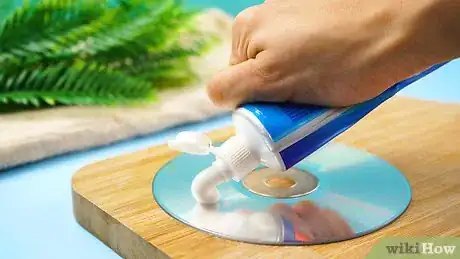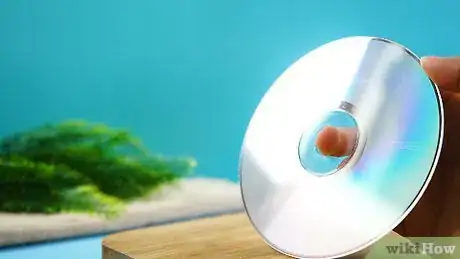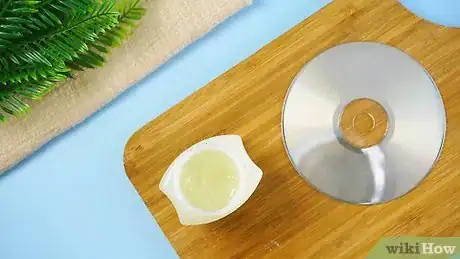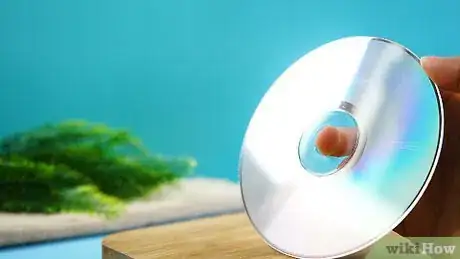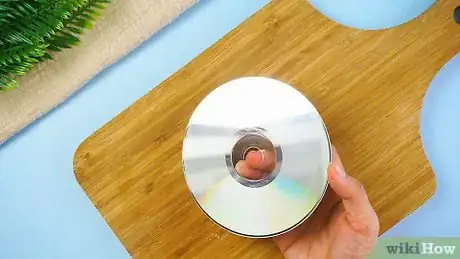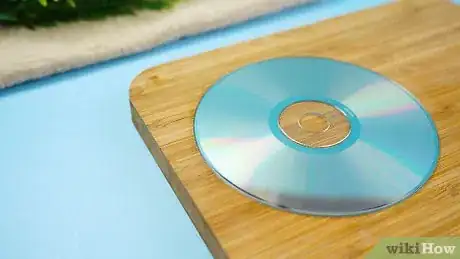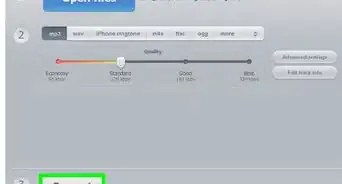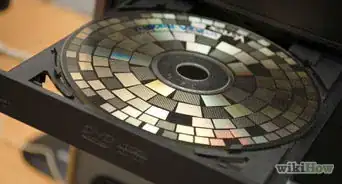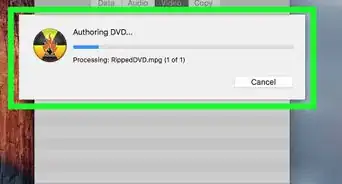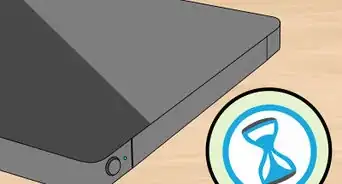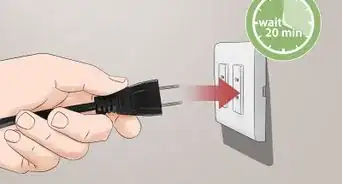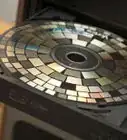This article was co-authored by wikiHow Staff. Our trained team of editors and researchers validate articles for accuracy and comprehensiveness. wikiHow's Content Management Team carefully monitors the work from our editorial staff to ensure that each article is backed by trusted research and meets our high quality standards.
The wikiHow Video Team also followed the article's instructions and verified that they work.
This article has been viewed 5,492,753 times.
Learn more...
Scratches and scuffs on CDs are very annoying - your favorite CD is now skipping the best songs, or maybe you're dealing with potentially losing an important document or program. You can find so many suggestions on the Internet about how to fix this problem, but we've found the very best three and have collected them here. Polishing the CD with a little toothpaste might be all you need, and if that doesn't work, try using an abrasive compound or coating the CD with wax.
Steps
Using Toothpaste
-
1Choose a basic toothpaste. There's no need for the sparkles, swirls, and exotic flavors of some oral care products. Instead, opt for a basic white paste to polish your CD. All types of toothpaste contain enough abrasive minerals to get the job done!
- Basic toothpastes are cheaper than their flashier alternatives. This can be especially helpful if you have several CD's to polish.[1]
-
2Apply toothpaste to the CD surface. Squeeze a small dab of toothpaste onto the scratched surface of your CD and spread it evenly over the surface of the CD with your finger.Advertisement
-
3Polish the CD. Using a radial motion, slowly work the toothpaste around the CD. Start at the center and move in a straight line outward.
-
4Clean and dry the CD. Run the CD under some warm water and rinse thoroughly. Then, using a soft, clean cloth, dry the CD and double check to make sure you've removed all traces of toothpaste or moisture.
- After you've cleaned and dried the CD, use a soft cloth to buff the surface of the CD.
Polishing with Abrasive Compounds
-
1Decide which compound you will use. A number of common household products can be used to polish the CD, but 3M rubbing compound and Brasso are probably the most tried and true. You can also use fine-grit polishing compounds designed for cars or hard finishes.
- If you're using Brasso, make sure to do so in a well-ventilated area, and avoid breathing in the fumes. Always read the safety instructions and warnings on any chemical product as many (such as rubbing alcohol) are flammable and/or can cause skin, eye, or respiratory irritation.[2]
-
2Apply the polishing compound to a cloth. Put a small amount of 3M compound or Brasso on a soft, clean, lint-free cloth. An old shirt or an eyeglass-cleaning cloth will both work well.[3]
-
3Polish the CD. Use a gentle, radial motion, to rub the compound into the scratch. Start at the center and rub out to the edge, like spokes on a wheel. Do this 10 or 12 times all around the CD. Try to focus your efforts solely on the scratch or scratches that you have identified.
- When polishing the disc, make sure to lay the disc on a flat, firm surface that's non abrasive. Data is stored on the foil or dye layers on the top of the disc (label side) and the protective top layer can easily be scratched or perforated. Pressing a disc on too soft a surface may crack it or cause it to de-laminate.
- Rubbing in a circular motion (as opposed to a radial motion) can cause small scratches that throw off the laser tracking system in the player.
-
4Remove the polishing product from the disc. Rinse the disc thoroughly with warm water and let it dry. Make sure to remove all of the compound and let the disc dry completely before trying to play it. With Brasso, wipe off excess product and let the rest dry. Then, using a clean cloth, gently wipe the disc again.
-
5Test the disc. If the problem persists, polish again for up to 15 minutes, or until the scratch is almost completely buffed out. The surface around the scratch should begin to look shiny with many tiny scratches. If you still do not notice any difference after polishing for a few minutes, the scratch may be extremely deep, or you may be polishing the wrong scratch.
- If the disc is still not operational, take the disc to a trained professional at a gaming store or CD repair shop.
Finishing With Wax
-
1Determine whether or not wax is an option. Sometimes you'll need to physically remove plastic from the disc by polishing. However, removing a lot of plastic can affect the refractive property of the lens making the data unreadable. Waxing scratches is useful because even though the defects are visible to your eye, the laser sees around/through them.[4]
-
2Wax the scratches. Apply a very thin coat of Vaseline, chap-stick, liquid car wax, neutral shoe polish, or furniture wax to the CD's playing surface. Let the wax sit in the scratches for a few minutes—remember, the idea is for the wax to fill in the scratch so it can be read again.[5]
-
3Wipe away the excess wax. Using a clean, soft, lint-free cloth, wipe in a radial (inside-to-outside) motion. If using wax, follow the manufacturer's instructions (some need to dry before you wipe them off, while others should be wiped off while still wet).
-
4Test the disc again. If the wax or Vaseline does the trick, burn a new disc immediately. The waxing method is only a temporary solution meant to get the CD working long enough to transfer the data to a computer or new disc.
Masking Tape Method
Before proceeding you should come to terms with the fact that holes in the foil layer of a CD are not repairable, not even by professionals. The best way to move past them is to skip them altogether so that at least the remaining data can be accessed and saved elsewhere.
-
1Hold the disc with its shiny side up in clear view of a bright light.
-
2See if any holes are visible on the shiny side.
-
3Flip the disc and mark the areas holes with a permanent marker.
-
4Take 2 small strips of masking tape and stick them on top of each other over the area you have just marked.
- Note: The CD might make a noise while running but you'll be able to access at least 70% of the data on it.
Community Q&A
-
QuestionHow do I know how deep the scratches are?
 Community AnswerBy observing the scratches with your eyes, you should be able to see how deep they are. (The reflection of the light will be a clue.)
Community AnswerBy observing the scratches with your eyes, you should be able to see how deep they are. (The reflection of the light will be a clue.) -
QuestionHow do I get the scratches off my DVD?
 Community AnswerThe methods for a scratched CD will work for a DVD as well.
Community AnswerThe methods for a scratched CD will work for a DVD as well. -
QuestionCan I use any kind of toothpaste for repairing DVD scratches?
 Community AnswerUse paste instead of a gel because it is grittier.
Community AnswerUse paste instead of a gel because it is grittier.
Warnings
- To prevent damage to your CD player, make sure that CD's are completely dry and free of excess polishing products or waxes before you attempt to play them.⧼thumbs_response⧽
- Understand that any CD repair method may cause additional damage. Make sure to follow the steps carefully.⧼thumbs_response⧽
- Do not apply solvents to CD surfaces as it changes the chemical composition of the polycarbonate substrate resulting in an opaque finish and an unreadable disc!⧼thumbs_response⧽
- If you hold the CD up to a bright light to check for holes in the foil layer, remember not to stare at the light for too long. A 60-100 Watt bulb should be more than enough to see pinholes in the foil layer. Do not use the sun!⧼thumbs_response⧽
Things You'll Need
- Clean, soft, lint-free cloth (microfiber cloths are excellent)
- Water (or rubbing alcohol)
- Brasso metal polisher, fine polishing compound or toothpaste
- Liquid car wax or Vaseline
- Cotton gloves or plastic food-handling gloves (they make it easier to handle CDs and not leave fingerprints)
References
- ↑ http://www.howtocleanstuff.net/how-to-fix-a-scratched-cd-or-dvd/
- ↑ http://www.mcgee-flutes.com/scratches.html
- ↑ https://diyvideoeditor.com/clean-repair-dvds-cds-game-discs/
- ↑ http://removeandreplace.com/2013/11/20/easily-fix-scratched-dvd-cd-fix-scratched-disc/
- ↑ http://www.digitaltrends.com/home-theater/how-to-fix-a-scratched-disc-dvd-cd/
About This Article
To fix a scratched CD, first squirt some toothpaste with baking soda in it onto the CD. Then, use a cotton swab to work the toothpaste into any deep scratches. Next, wipe the toothpaste around the disc in a circular motion with a paper towel or a microfiber cloth. Rinse the toothpaste off with cool water. You can also use metal polish to remove CD scratches. Pour a small amount of metal polish into a clean microfiber cloth. Wipe around the disc in a circular motion to spread the metal polish around. Then, wipe the excess polish off with a clean, dry cloth. Another option is to use petroleum jelly. Just spread some petroleum jelly around the disc with your finger so it's completely covered to fill in any scratches. Then, wipe off the excess with a clean microfiber cloth. Lip balm, furniture wax, and shoe polish will also work for this.
